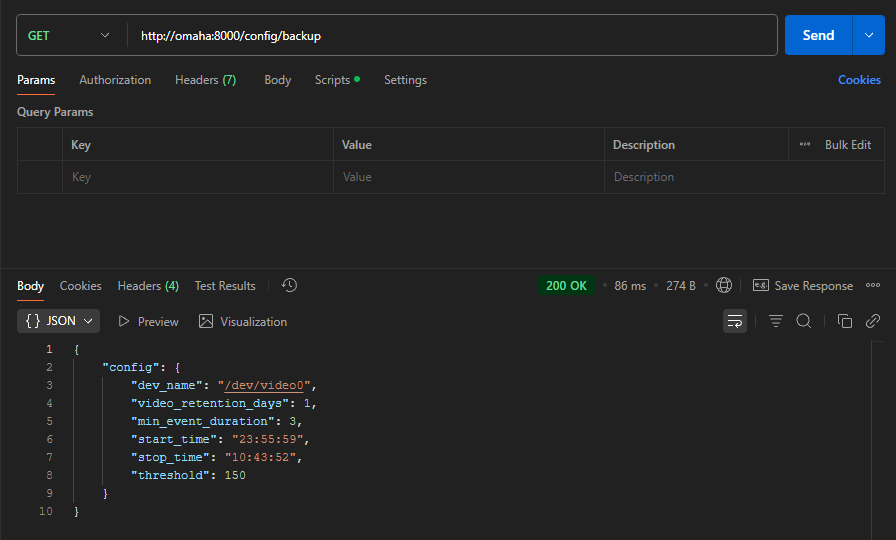Icarus API
Each node running Icarus hosts its own FastAPI server for communication with Heimdall.
FastAPI automatically generates API docs, which can be found by going to <node_name>:8000/docs. For example, omaha:8000/docs
This section will offer a more detailed explanation of what each route on Icarus is doing and what they are used for.
Routes
IoT Routes
These endpoints are used by the IoT setup and are not meant to be accessed normally.
They are used only for the WiFi configuration interface.
GET /connect
Parameters
This endpoint does not require a request body.
Responses
- Status:
200
Body: HTML response showing network connectivity page
Description
This endpoint renders the WiFi connection interface page that allows users to connect the Icarus node to a WiFi network. The page presents a form with available networks and allows users to ender credentials to connect.
The endpoint builds context (available networks, current connection status), and uses this to construct this page.
POST /connect
Parameters
This endpoint expects query parameters:
ssid: WiFi network name
bssid: WiFi network access point name
password: The network password
Responses
-
Status:
200(Successfully connected to WiFi network)
Body: Returns an HTML page with a success message indicating the node has successfully connected to the network.The success page includes:
- Confirmation of connection
- Network name (SSID)
- Internet connectivity status
-
Status:
200(Failed to connect to WiFi network)
Body: Returns an HTML page with an error message indicating the node failed to connect.The failure page includes:
- Error message
- Attempted network name (SSID)
Description
This endpoint processes WiFi credential submissions from the connection form. It attempts to connect the Icarus node to the specified WiFi network using the provided credentials.
It is called from pressing the Connect button on the WiFi connection page. Under the hood, an hx-post in connect.html is called, passing in the username and password.
This endpoint is rate-limited to 10 requests per minute per IP address to prevent abuse.
Common reasons why user failed to connect Icarus to their network:
- Incorrect password
- Network out of range
- Network permissions/authentication issues
POST /rescan
Parameters
This endpoint does not require a request body.
Responses
- Status:
200
Body: Returns an updated HTML page with the refreshed list of available WiFi networks.
Description
This endpoint triggers a rescan of available WiFi networks in the vicinity of the Icarus node and refreshes the network selection interface. It's used to detect new networks that have appeared since the page was loaded or to update signal strength information.
The endpoint builds context (available networks, current connection status), and uses this to construct this page.
It is called from pressing the Rescan button on the WiFi connection page. Under the hood, an hx-post in connect.html is called.
This endpoint is rate-limited to 10 requests per minute per IP address to prevent abuse.
Heimdall-Accessed Routes
These endpoints are the ones used by Heimdall.
POST /reset
Parameters
This endpoint does not require a request body.
Responses
-
No Responseortimeout
This would indicate the Icarus successfully reset its WiFi connection due to the fact that without WiFi, no response is able to be sent. -
Status:
503
Body:Cannot reset Icarus WiFi connections due to the node currently recording.{ "message": "Cannot reset, node is currently recording" } -
Status:
500
Body:Failed to reset the WiFi connections.{ "message": "This message can only be received if the node's network didn't get deleted, indicating an error" }
Description
This endpoint deletes all of Icarus' known networks. If it is successful, then Icarus will go offline. It's typically used to troubleshoot network issues or to reconfigure the node's network settings from scratch.
This endpoint is not ever called by Heimdall. The functionality exists, but is missing backend implementation in Heimdall. It should be called by Heimdall after pressing the Restart Node
button:
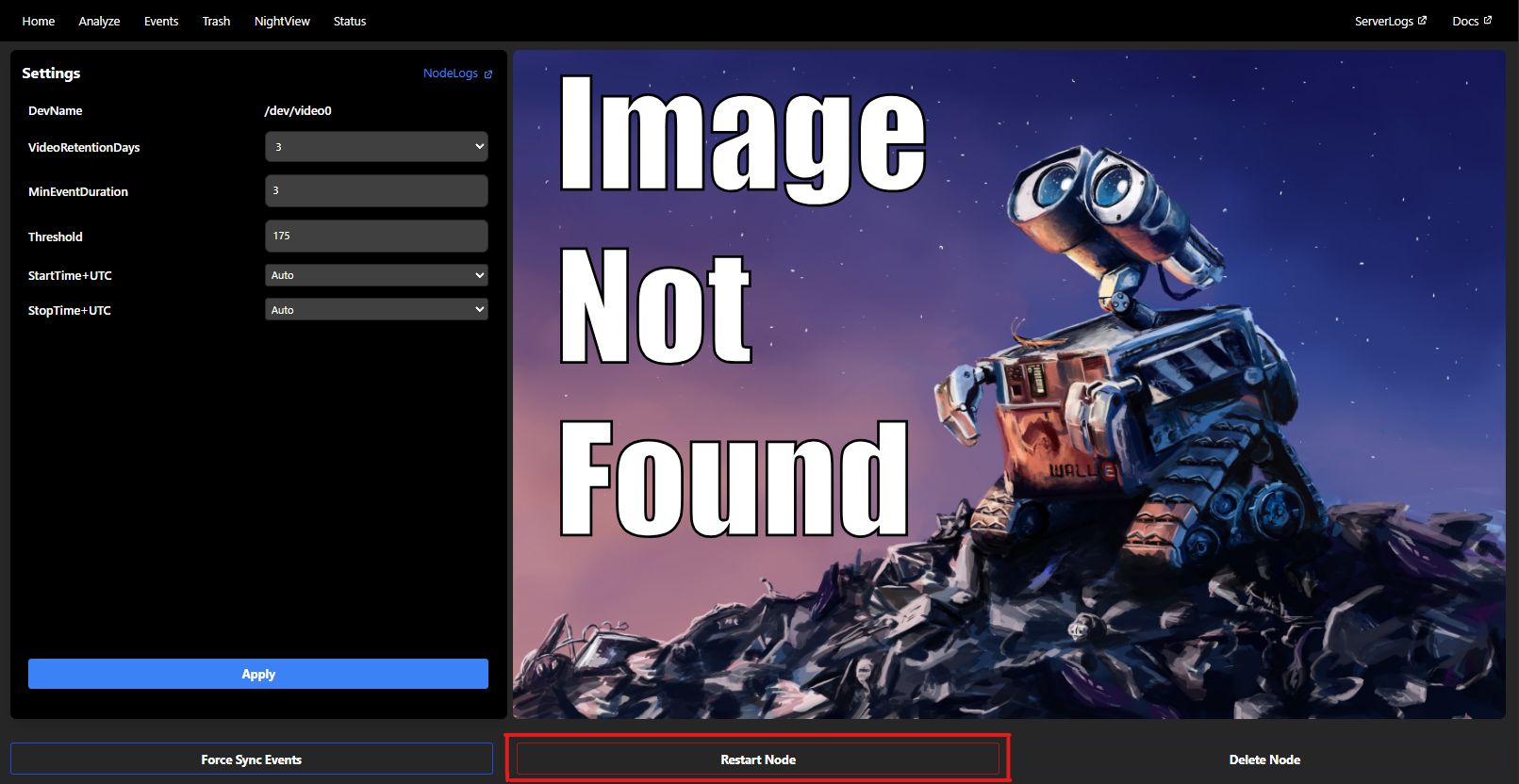
If you would like to implement this functionality, then
func (s *FiberServer) softResetHandler in heimdall/server/internal/server/routes.go is where you would do it.
All it would take is calling this endpoint (POST reset) using the nodeName parameter, and of course handling the different responses correctly.
If a recording is in progress, the endpoint will refuse to reset the network to prevent disrupting data capture.
This endpoint is rate-limited to 5 requests per minute per IP address to prevent abuse.
GET /gps
Parameters
This endpoint does not require a request body.
Responses
-
Status:
200
Body:The lat and lon of the node are returned as floats.{ "lat": 31.416, "lon": 42.069 } -
Status:
404
Body:GPS receiver is unable to determine location accurately.{ "status": "error", "message": "No valid GPS fix available", "gps_response": "<GpsResponse No fix>" } -
Status:
404
Body:Failed to connect to the GPSD instance.{ "status": "error", "message": "Failed to connect to GPSD instance", "error": "Unexpected data received as welcome. Is the server a gpsd 3 server?", }
Troubleshooting:
Runsystemctl status gpsdin the node's terminal. It should look like this:
If the service is not active, consider restarting it withsudo systemctl restart gpsdand then runningsystemctl status gpsdagain.
Consider also runninggpsmon, check to see if data is showing up. Use ctrl+C to exit it.
Description
Icarus will attempt to get the GPS coordinates of the node it is running on using the GPSD instance.
There could be many reasons why the GPS is unable to determine location accurately:
- Buildings, tunnels, or dense urban areas – GPS signals are line-of-sight; tall structures can block or reflect signals (multipath effect).
- Indoor or underground use – Most consumer GPS devices struggle without a clear sky view.
- Heavy cloud cover, storms, or solar activity – While GPS signals penetrate clouds, severe weather can slightly degrade accuracy.
- Ionospheric delays – Solar flares and atmospheric disturbances can slow signal transmission, causing minor errors.
- Less than 4 satellites in view – GPS requires at least 4 satellites for a 3D fix (latitude, longitude, altitude). Fewer satellites reduce accuracy or prevent a lock entirely.
For more information about GPSD and possible errors, check out
Python GPSD library
GPSD Documentation
Example
curl -X GET http://omaha:8000/gps
{"lat":40.23232344,"lon":-23.404011797}
GET /sensor
Parameters
This endpoint does not require a request body.
Responses
- Status:
501
This endpoint is not implemented.
Description
It is intended to be a health check for the sensors on the node (water sensor, humidity sensor).
Example
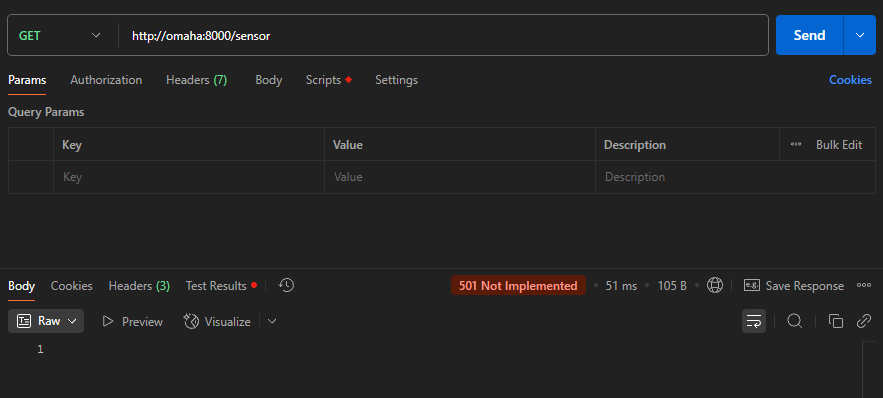
GET /status
Parameters
This endpoint does not require a request body.
Responses
- Status:
200
Body:{ "status": "online" }
Description
Heimdall uses this to check if Icarus is running on the node.
Example

PATCH /config
Parameters
This request requires a body containing valid keys and values for the NodeConfig class.
You can send any number of these key value pairs, meaning you are not required to send a whole serialized NodeConfig class if you are not updating every key.
Example Bodies:
{
"threshold": 150,
"video_retention_days": 1,
"min_event_duration": 3,
"start_time": "23:15:00",
"stop_time": "10:30:00"
}
{
"threshold": 170,
"stop_time": "10:30:00"
}
{
"min_event_duration": 5,
}
Responses
-
Status:
200
Body:
The body of a successful response has three parts.{ "accepted_fields": { "threshold": 150, "min_event_duration": 3, "start_time": "23:15:00", "stop_time": "10:30:00" }, "rejected_fields": {}, "patched_config": { "dev_name": "/dev/video0", "video_retention_days": 1, "min_event_duration": 3, "start_time": "23:15:00", "stop_time": "10:30:00", "threshold": 150 } }accepted_fieldsare the key value pairs you send in the request body that were accepted and changed in theNodeConfigobject.rejected_fieldsare key value pairs that either cannot be changed or do not exist.pathced_configis what the newNodeConfigobject looks like after updating.
There is another case where a200status is returned. If Icarus is currently recording and is sent a request containing updatedstart_timeorstop_timevalues and other valid keys such asthresholdormin_event_duration, then Icarus will update any valid key value pair that is notstart_timeorstop_time.
For example if Icarus is currently recording and we send the following body:
The response body will look like this:{ "threshold": 170, "start_time": "07:30:00", "stop_time": "10:30:00" }
Note how{ "message": "updated non schedule-related fields", "detail": "non-schedule fields updated successfully, but recording schedule cannot be modified while the node is recording", "accepted_fields": { "threshold": 170 }, "rejected_fields": { "start_time": "07:30:00", "stop_time": "10:30:00", }, "patched_config": { ... previous values "threshold": 170 }, }thresholdis updated in theNodeConfigbutstart_timeandstop_timewere not. This is because Icarus is unable to change the recording schedule while recording. -
Status:
503
Body:
This occurs if Icarus is recording and the only valid keys in the body are{ "message": "failed to change recording schedule", "detail": "cannot change recording schedule while node is recording", "start_time": <start_time>, "stop_time": <stop_time>, }start_timeand/orstop_time. -
Status:
400Body:
There are two ways a400response could be returned.
Fields in the body of the request were not allowed to be mutated. For example{ "status": "error", "message": "Cannot mutate fields", "immutable_fields": [immutable_keys], }dev_nameis a field of theNodeConfigclass, but cannot be mutated.The request's body has malformed or invalid data.{ "status": "error", "message": "Error validating data", "errors": [validation_errors], }
For example if we sent the following body in the request:We would get a{ "threshold": "foobar", "foo": "bar", "baz": 12414 }400response with the following body:The possible errors that can occur fall into two categories: Validation and Extra.{ "status": "error", "message": "Error validating data", "errors": [ { "type": "int_parsing", "field": [ "threshold" ], "input": "foobar", "message": "Input should be a valid integer, unable to parse string as an integer" }, { "type": "extra_forbidden", "field": [ "foo" ], "input": "bar", "message": "Extra inputs are not permitted" }, { "type": "extra_forbidden", "field": [ "baz" ], "input": 12414, "message": "Extra inputs are not permitted" } ] }
Validation errors occur when the data sent fails to pass theNodeConfigvalidators. In this example we can see that we sent"threshold": "foobar", butthresholdhas a validator that requires it to be an integer (or string that is parsed into an integer).
Extra forbidden errors occur when the data sent has extraneous fields that do not exist in theNodeConfigclass. This is due toNodeConfignot allowing extra fields to be given to itself. The keysbazandfooare not actual fields in theNodeConfigclass and therefore are rejected.
Description
The description under each response sums up the functionality of this endpoint.
This endpoint is hit when "Apply" is pressed after updating a node's config in its setting page on Heimdall.
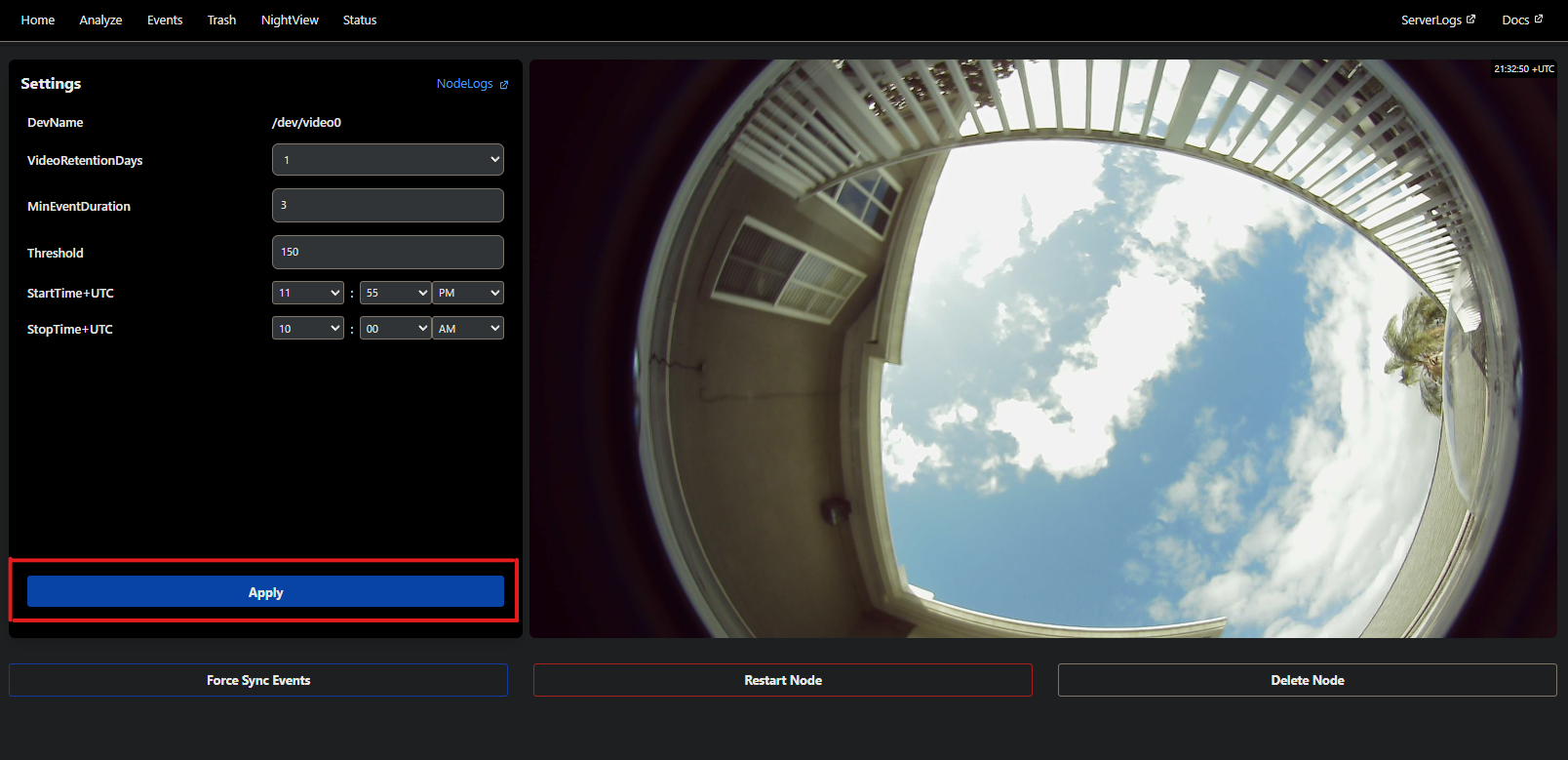
Example
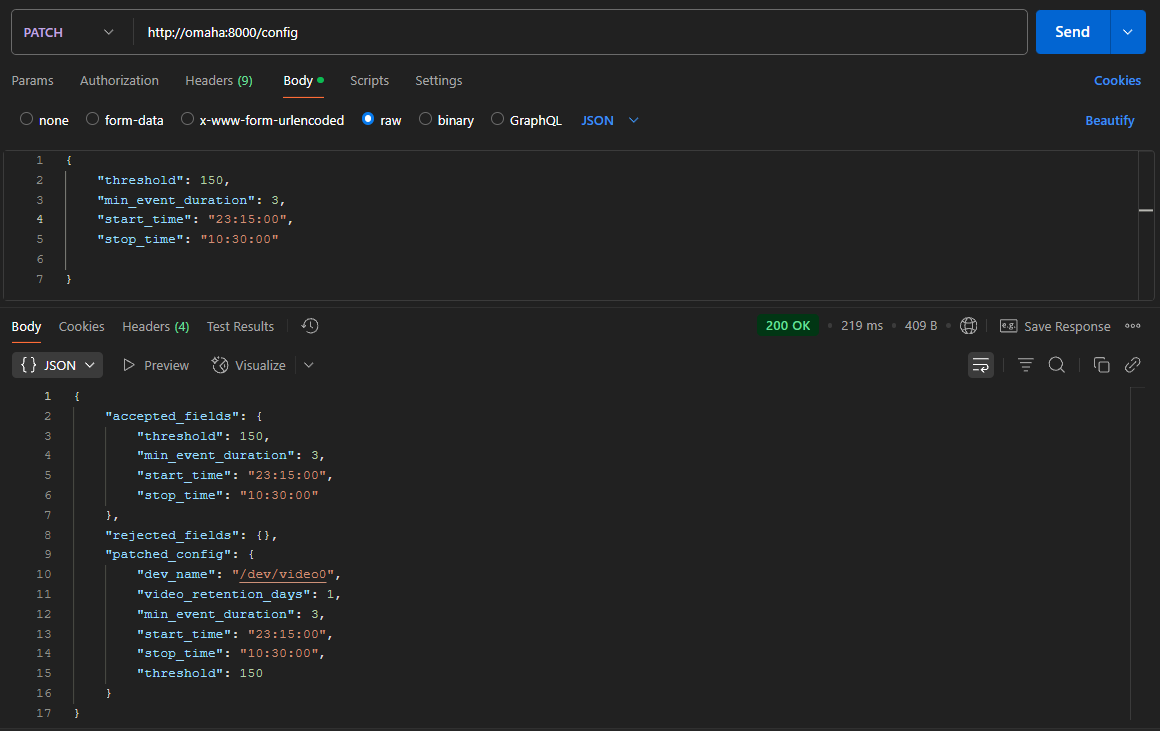
GET /nights
Parameters
date: Date that you want to get night recordings for. Must be formatted as YYYY-MM-DD.
Responses
-
Status:
200
Headers:
content-type: application/zip
content-disposition: attachment; filename="<node_name>-<date>.zip"
Body:
The zipped night recordings binary data. -
Status:
404
No recordings exist for the specified date.{ "message": "No folders exist for given date", "date": <date> } -
Status:
503
Icarus is busy recording and cannot check for night recordings.{ "message": "Cannot fetch night data while recording" } -
Status:
400
Body:{ "message": "Date parameter is required" }datequery paramter is missing from the request.
{ "message": "Invalid date format. Use YYYY-MM-DD", "date": <date> }datequery paramter is not formatted correctly.
Description
This endpoint is internally called by Heimdall after receiving a 200 response code from HEAD /nights. Note that this endpoint is returning a massive (yes the meme is still massive) zip file and will therefore take a very long time to finish execution.
Example
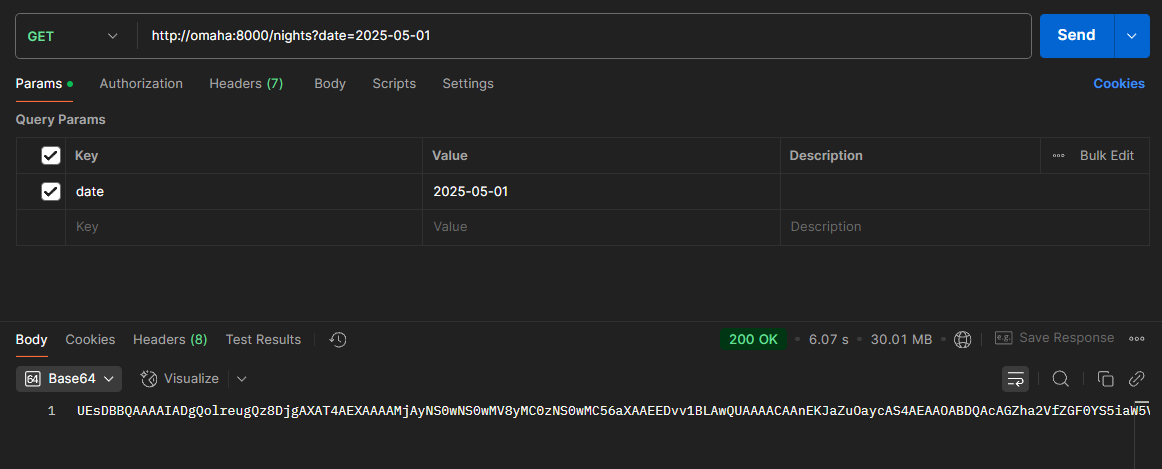
HEAD /nights
Parameters
date: Date that you are checking for night recordings. Must be formatted as YYYY-MM-DD.
Responses
Since this is a HEAD request, none of the responses have a body.
-
Status:
200
There exists recordings for the specified date. -
Status:
404
No recordings exist for the specified date. -
Status:
503
Icarus is busy recording and cannot check for night recordings. -
Status:
400
Either the date query parameter is missing in the request or it is malformed. Thedatequery parameter must be formatted asYYYY-MM-DD.
Description
Because GET /nights could potentially take a long time to download the whole night's recording, this endpoint is used by Heimdall to check if the date has a recording. Heimdall uses the status code of the response to either do nothing or to hit GET /nights. Heimdall will only hit GET /nights if a 200 status code is returned from this endpoint.
Heimdall hits this endpoint when "Download Night" is pressed in the "NightView" page.

Example
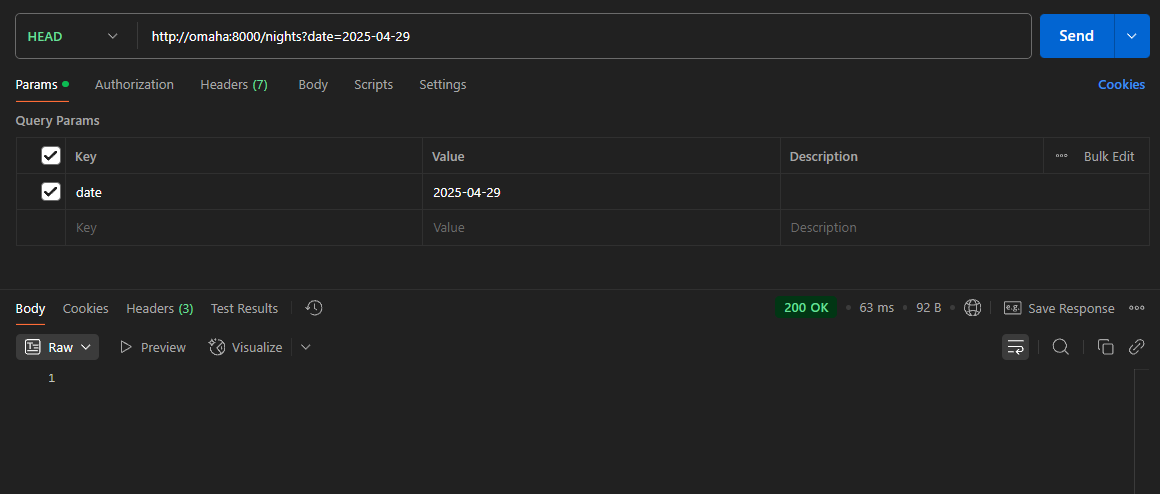
GET /snapshot
Parameters
This endpoint does not require a request body.
Responses
-
Status:
200
Headers:
content-type: image/jpeg
content-disposition: attachment; filename="<node_name>-snapshot-<timestamp>.jpg"
Body:
The snapshot binary data. -
Status:
503
Service Unavailable.
Icarus cannot get a snapshot while it is recording because the camera can only be accessed by one video capture. -
Status:
500
Body:
There are serveral bodies that could be returned in a500status.
Icarus failed to open the camera device to get a snapshot. This could be because a process still hasn't released the camera video capture, or because the camera device is not properly set up.{ "message": "Failed to open camera device" }
To get a snapshot, Icarus will grab a few seconds of frames in order for the camera exposure to be properly set. If a frame fails to grab during this exposure set time, this response is returned.{ "message": "Failed to grab frame" }
Icarus failed to read the frame that would be used for the snapshot.{ "message": "Failed to capture snapshot" }Icarus failed to write the frame that it captured to a temporary jpg file. This could possibly happen if the node doesn't have file write permissions.{ "message": "Failed to save snapshot" }
For further debugging help, check out cv2.imwrite(), the function used to write snapshots.
Description
Icarus opens up the camera device whose path is specified in NodeConfig.dev_name. In order to make sure that the snapshot is clear (not super bright or super dark), Icarus captures 2 seconds of frames before saving one frame to use as the snapshot. The snapshot is saved to a temporary file in the /tmp directory and then sent to Heimdall. After the snapshot is sent to Heimdall successfully, the temporary snapshot in the /tmp directory is deleted.
Example
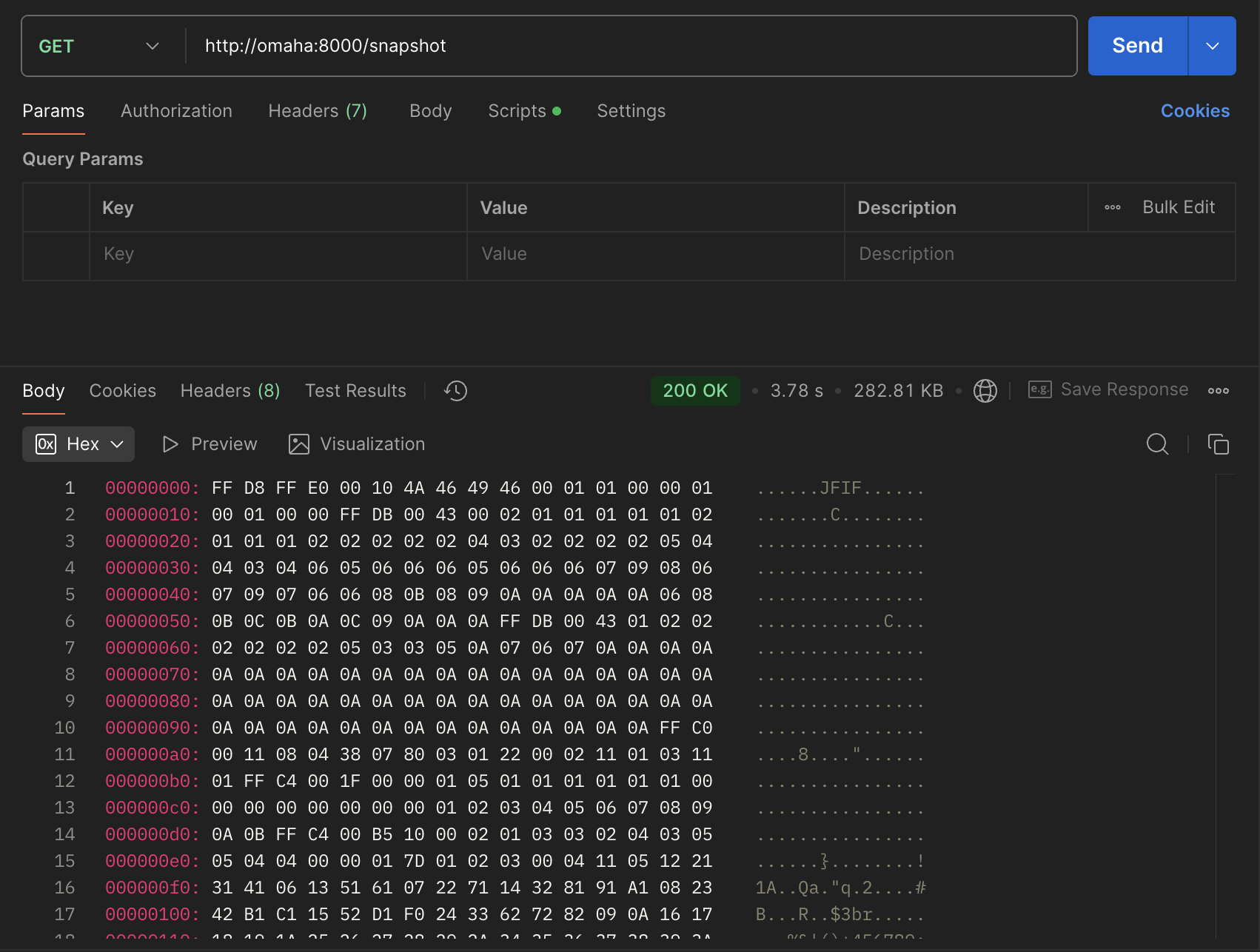
POST /serq/trigger
Parameters
This endpoint does not require a request body.
Responses
-
Status:
200
Body:Icarus successfully processed the retry queue.{ "message": "Send event retry queue processed", "queue_size": 0, }
The size of the queue after it was processed is returned.
Note that the queue size could possible be greater than 0, this would happen if an event fails to send again and would therefore be put back into the queue. -
Status:
503
Body:If the node is recording then Icarus cannot process the event retry queue.{ "message": "Cannot process send event retry queue while node is recording" }
Description
This endpoint is triggered from the "Force Sync Events" button located in a node's settings page.

Attempts to process the whole send event retry queue for the node. This means that any event that the node had previously failed to send to Heimdall will try to be sent again.
If the resending of an event fails, the event is placed back into the retry queue and waits until the queue is processed again.
Example
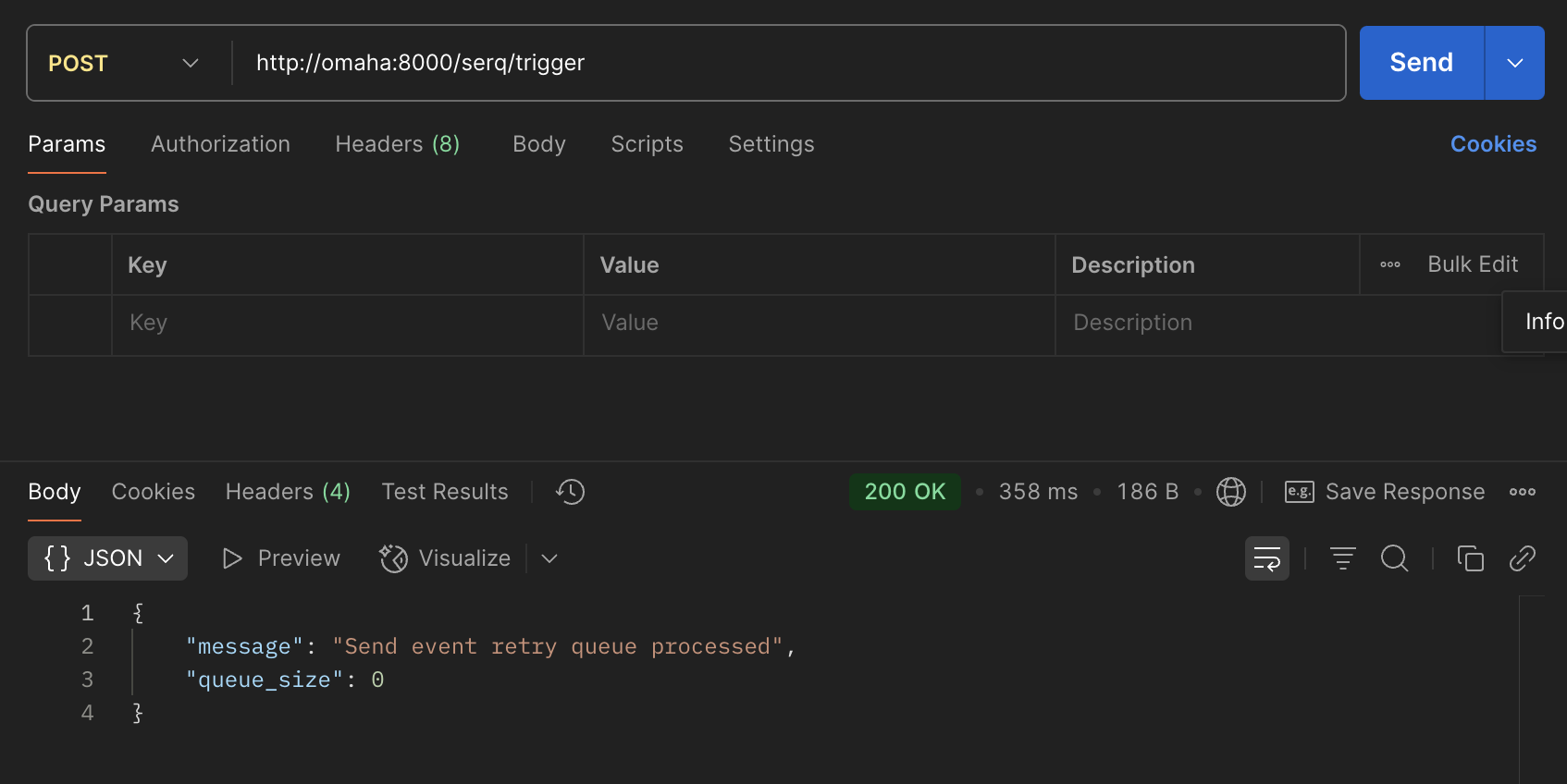
Debugging Routes
These endpoints are not used by IoT or by Heimdall, they are only used for tests and for debugging.
GET /
Parameters
This endpoint does not require a request body.
Responses
- Status:
200
Body:{ "name": "Bolide Node API", "description": "This API provides access to information about this node", "documentation": "http://<node_name>:8000/docs" }
Description
This root endpoint returns general information and where to find more docs.
Example
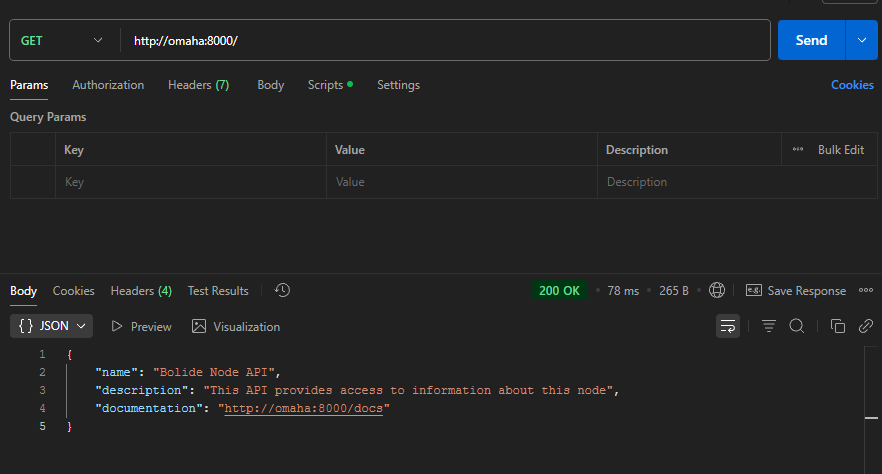
GET /config
Parameters
This endpoint does not require a request body.
Responses
- Status:
200
Body:{ "config": { "dev_name": "/dev/video0", "video_retention_days": 1, "min_event_duration": 3, "start_time": "23:55:59", "stop_time": "10:43:52", "threshold": 150 } }
Description
Returns the current NodeConfig object as JSON.
This endpoint should only be used for debugging and testing.
NOTE: Do not use this endpoint to update the node's NodeConfig record in Heimdall's database.
Example
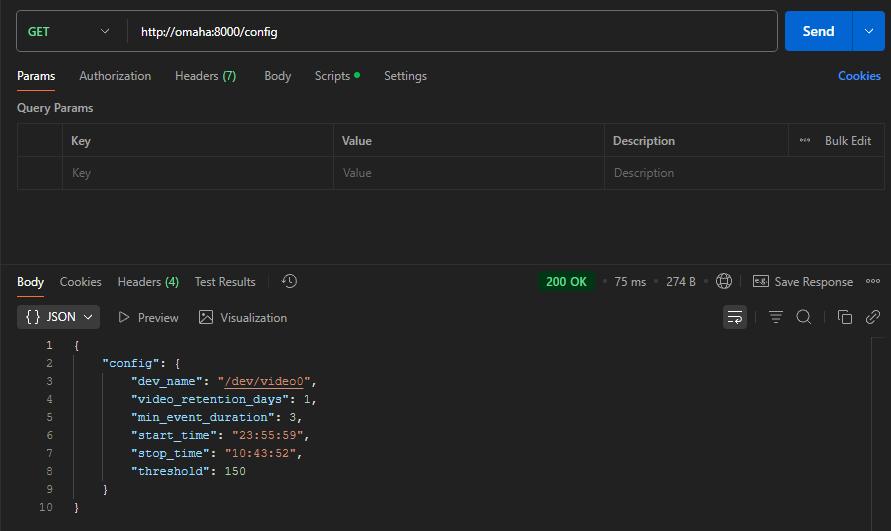
GET /config/backup
Parameters
This endpoint does not require a request body.
Responses
- Status:
200
Body:{ "config": { "dev_name": "/dev/video0", "video_retention_days": 1, "min_event_duration": 3, "start_time": "23:55:59", "stop_time": "10:43:52", "threshold": 150 } }
Description
Returns the current NodeConfig as JSON that is stored in the config.bak file.
This endpoint should only be used for debugging and testing.
NOTE: Do not use this endpoint to update the node's NodeConfig record in Heimdall's database.
Example
